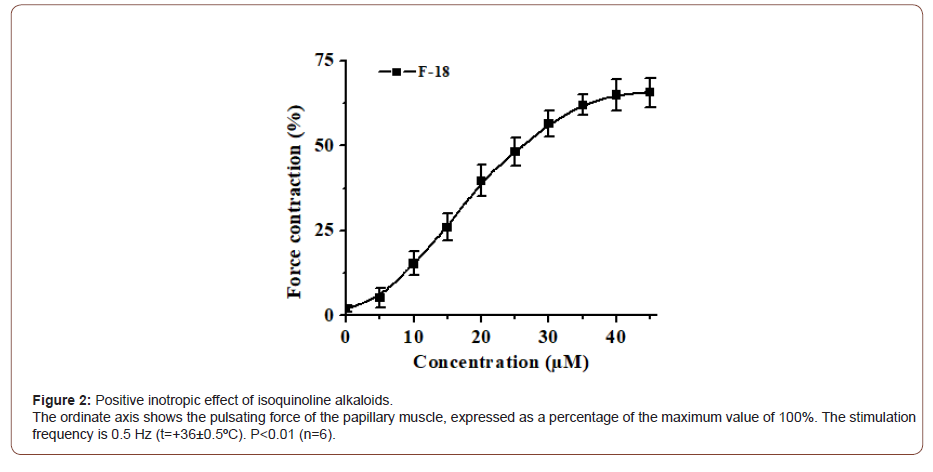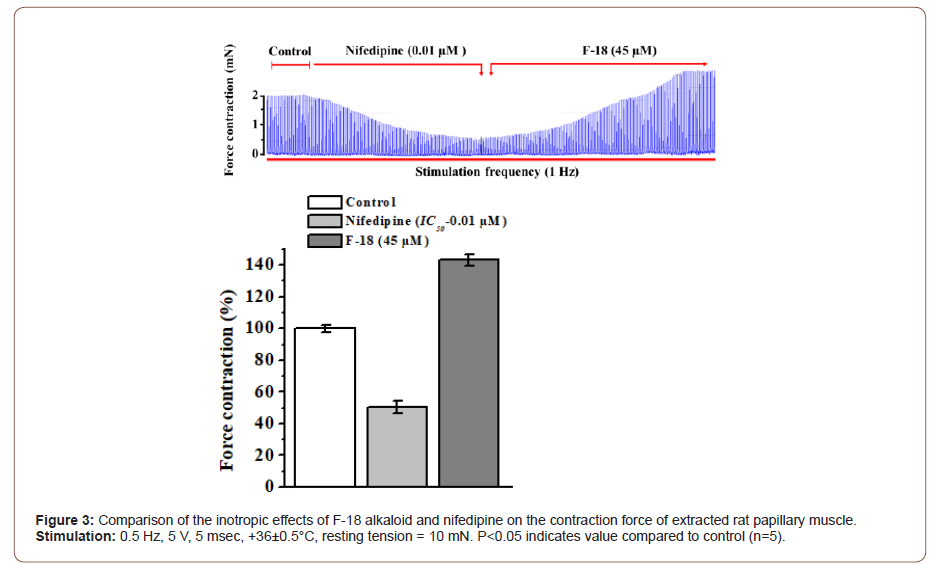Abstract
This study evaluated the mechanism of inotropic effect of an isoquinoline alkaloid derivative, 1-(2´-bromine-4´,5´-dimethoxyphenyl)-6,7- dimethoxy-1,2,3,4- tetrahydroisoquinoline (F-18) using electrically stimulated rat left ventricular papillary muscle of rat. The F-18 alkaloid have been shown to have positive inotropic effect on papillary muscle contraction activity, IC50 value -14,6 μM. Са2+L-channel blocker - nifedipine was used in experiments. Inotropic effects of F-18 isoquinoline alkaloid on cardiomyocytes were suggested, based on results obtained in experiments carried in cardiomyocytes SR Са2+- transport systems modulation.
Keywords:Papillary muscle; Inotropic effect; Isoquinoline alkaloid
Introduction
Isoquinoline alkaloids constitute one of the largest groups of plant-derived compounds with a wide range of pharmacological activities are a promising candidate for developing new cardiovascular drugs. A significant number of isoquinoline alkaloids possess a potent antiarrhythmic activity mediated through multiple cellular mechanisms [1]. The antiarrhythmic effect of the well-known representative of these alkaloids tetrandrine are provided by blockage of L- and T-types calcium and sodium channels with slow recovery kinetics, thus terminating acute episodes of paroxysmal supraventricular tachycardia [2]. It also has been demonstrated that tetrandrine exerted a substantial positive inotropic and chronotropic effects associated with decreased intracellular Ca2+ due to the blockage of the voltage-operated Ca2+ channels and modulation of the sarcoplasmic reticulum Ca2+ loading and release functions [3]. Positive inotropic of tetrandrine, like most antiarrhythmic drugs, resulting in reductions in cardiac contractility and cardiac output is a serious adverse effect, limit its use in patients with already impaired left ventricular function [4].
Recently, with the aim to find new effective antiarrhythmic agents a series of hydroxyethyl derivatives of 1-aryltetraisoquinoline alkaloids were synthesized [5, 6]. In previous studies the effects of these derivatives on rat left ventricular papillary muscle contractility we found that among them the most potent positive inotropic activity exert 1-(2´-bromine-4´,5´-dimethoxyphenyl)-6,7- dimethoxy-1,2,3,4- tetrahydroisoquinoline, designated as F-18. Therefore, the aim of this study was further to characterize the positive inotropic effect of this new isoquinoline derivative and to define the mechanism of this action (Figure 1). The chemical structure of the synthesized 1-(2´-bromine-4´,5´-dimethoxyphenyl)- 6,7-dimethoxy-1,2,3,4- tetrahydroisoquinoline is proven with the help of NMR data 1N and 13C spectra. In NMR 1N, the spectrum of the protons of the aromatic ring N-5 and N-8 is observed in the form of singlets at 6.64 ppm. VA δ 6.26 ppm, the n-1 of the methyine group resonates in the form of a singlet at δ 5.43 ppm. Signals NMR 1N and 13C confirmed education 1-(2´-bromine-4´,5´-dimethoxyphenyl)- 6,7-dimethoxy-1,2,3,4- tetrahydroisoquinoline (4а) С19Н22О4NBr.

Material and Method
All experimental protocol and conditions for preoperative care were approved by the animal use committee of the Institute of Biophysics and Biochemistry. Adult male Wistar rats weighing 200–250g were anesthetized with sodium pentobarbital (50 mg/ kg-1, i.p.) and then sacrificed by cervical dislocation. The papillary muscles from the left ventricles of the rat hearts about 0,5-0,8 mm in diameter and 1-3 mm in length were dissected and mounted in a tissue bath (STEIRT, HSE, Germany) of 3 ml volume and superfused at a rate of 20 ml min-1 with Krebs solution. The composition of the Krebs solution was (in mM) NaCl, 118; KCl, 4.7; MgSO4 , 1.2; KH2PO4, 1.2; glucose 10; NaHCO3, 24; CaCl2, 2.54. The solution was continuously gassed with 95% O2 and 5% CO2 to give a pH of 7.4 and was maintained at 37°C. Preparation of tissue and measurement of contractility and setup of the equipment. In experiments the papillary muscles preparations, isolated from the right atrium of adult albino rats’ hearts. Rats were deeply anaesthetized with diethyl prior to paralyzing by using cervical dislocation method. The papillary muscles were -0.4-1.3 mm in diameter and 2.5- 3.8 mm in length. Isometric tension forces were recorded using a force transducer (SI-KG20, World Precision Instruments, Inc. 175 Sarasota Center Boulevard, Florida 34240-9258, USA), designed for the in vitro study in standard pharmacological experiments for measuring contraction force response of isolation muscle preparations. The organ chamber (20 ml) was part of the experimental setup, as shown in (Figure 2). For further details of setup of the recording system is given in the text.

The Isometric force transducer SI-KG20 is connected to a transducer amplifier (SI-BAM21-LCB, WPI, Inc. 175 Sarasota Center Boulevard, Florida 34240-9258, USA). The papillary muscle was lifted with electric impuls that was higher than threthold (-20%), rectangular, electrical pulses of frequency 0.5 Hz; 5-10 msec and 5 V amplitude, delivered via a pair of platinum electrodes placed in the muscle-mounting organ chamber by using stimulator ESL-2 (Russia).
Drugs and Reagents
The derivative of isoquinoline alkaloid 1-(2´-bromine-4´,5´- dimethoxyphenyl)-6,7-dimethoxy-1,2,3,4- tetrahydroisoquinoline (F-18) was synthesized by the Bischler-Napieralski cyclization with 3,4-disubstituted phenethylamine and aromatic acetic acid as starting materials in Institute of Plant compounds Uzbek Academy of Sciences. Nifedipine, lidocaine were purchased from Sigma- Aldrich Chimie (Sigma, St. Louis, MO, U.S.A.). Data are expressed as mean ± SD. Control values between groups were compared by analysis of variance. The Student’s t-test was used to compare two means. A probability of less than 0.05 was taken as a statistically significant difference. Statistical analysis was performed using OriginPro 7.5 software (OriginLab Co., U.S.A).
Result And Discussion
The large number of data received in recent years testifies to the development of energy metabolism in cardiomococytes to play a leading role in the development of pathological processes in the heart. It causes dysfunction of the ryanodine receptor (RyR2), sarcoplasmic reticulum Ca2= ATPaseis (SERCA2a), Na+/ Ca2+ exchanger in the absence of ATF [7]. When we tested the dosedependent effect of the F-18 alkaloid on rat heart papillary muscle contraction activity, it was found that this alkaloid had a positive inotropic effect at all concentrations. Initially, the F-18 alkaloid showed no significant effect on the contraction force of papillary muscle from 1 μM to 5 μM, and a positive inotropic effect from 5 μM was observed. The F-18 alkaloid was found to have a maximal effect at 45 μM and an increase in muscle contraction force relative to control - 65.6±4.4% (Figure 2). The semi-maximum effective concentration (EC50) of the alkaloid F-18 was 14.6 μM, respectively.
It is known that the basis of the inotropic effect of various pharmacological agents on myocardial contractile activity lies in the change in the amount of [Ca2+sup>]in cardiomyocytes, which occurs through the modulation of the activity of various Ca2+sup>-transport systems [8]. One of the main causes of positive inotropism is due to the modulation of Ca2+sup> L -channel activity in cardiomyocytes and, in turn, the change [Са2+]in. In subsequent experiments, the positive inotropic effect of the alkaloid F-18 on the activity of the potentialactivating Ca2+sup> L -channel located in the cardiomyocyte sarcolemma was carried out in the presence of a specific blocker of the Ca2+L -channel - nifedipine (IC50-0.01 μM). It was found that the positive inotropic effect of F-18 (45 μM) in the presence of nifedipine 0.01 μM in the medium was 21.7±3.8%, respectively, relative to the control (Figure 3).

From this experiment, it can be concluded that the positive inotropic effect of the alkaloid F-18 indicates a low involvement of potential-dependent activating Ca2+ L–channels located in the cardiomyocyte sarcolemma, as well as the presence of other mechanisms. Са2+ ions from SR play an important role in the process of contraction of the heart muscle. In subsequent experiments, the effect of the F-18 alkaloid on the positive inotropic effect on SR Са2+ concentration was studied. The post-rest potency method was used to assess the effect of SR Са2+. The process of post-rest potentiation is explained by a sharp increase in the initial contraction force when this heart muscle excitation is stopped for 30 seconds and resumed after a certain period of rest. After 30 seconds of rest, cardiomyocytes accumulate more Ca2+ ions than in the previous physiological order of SR, and more Ca2+ ions are released into the cytosol when reactivation is given. In this case, a sharp increase in the initial contraction force is observed. Post-rest potency is an adequate method widely used in the study of changes in SR Ca2+ concentration in cardiomyocytes [9].
In our control experiments, the amplitude of the first contraction force was set to 100% when the papillary muscle stimulation was stopped for 30 s and returned to the previous excitation. Under these conditions, the F-18 alkaloid was found to increase the post-rest potency value by 157.4±4.1% relative to the control under the influence of 45 μM (Figure 4). According to the analysis of the results of this experiment, it can be assumed that the positive inotropic effect of the alkaloid F-18 increases the concentration of [Ca2+]i in cytosol by activating SR function. Data are reported as mean ± SEM (n=5) and expressed as a percentage of control contraction, obtained in normal Krebs solution at 0.1 Hz before the addition of drugs, which was taken as 100%. P < 0.05 vs baseline.

Conclusion
All of the above experiments show that the positive inotropic effect of the alkaloid F-18 partially affects the potential-activating Ca2+ L-channels located in the cardiomyocyte sarcolemma and mainly affects the SR function, increasing the amount of Ca2+ L ions released, resulting in post-rest potency in papillary muscle an increase in the value is observed. The positive inotropic effect of the F-18 alkaloid is explained by its effect on SR by increasing the amount of Ca2+ ions accumulated and excreted.
To read more about this article...Open access Journal of Cardiology Research & Reports
Please follow the URL to access more information about this article
https://irispublishers.com/ojcrr/fulltext/description-of-the-mechanism-of-positive-inotropic-action-of-the-isoquinoline-alkaloid.ID.000611.php





No comments:
Post a Comment